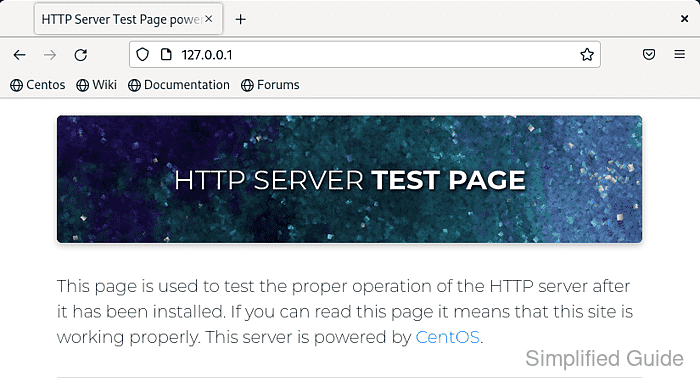Installing the Apache HTTP Server (httpd) provides a standard, well-supported way to serve websites and internal applications on CentOS, Red Hat, and Fedora. A correct base setup avoids common first-run problems like a service that starts but is unreachable due to firewall policy.

On these distributions, Apache is delivered as the httpd package and managed as the systemd unit httpd.service. Most server-wide settings live in /etc/httpd/conf/httpd.conf, while additional configuration and module snippets are commonly loaded from /etc/httpd/conf.d.
A working setup depends on three moving parts lining up: a valid configuration (checked with apachectl configtest), a running service (managed with systemctl), and network policy that permits inbound HTTP and HTTPS (typically firewalld). When serving content outside the default document root or listening on non-standard ports, SELinux contexts and port labeling may also need updates to prevent silent access denials.
Steps to install and configure Apache on CentOS, Red Hat or Fedora:
- Open a terminal with sudo privileges.
- Install the Apache package using the system package manager.
$ sudo dnf install --assumeyes httpd [sudo] password for user: Updating Subscription Management repositories. Unable to read consumer identity This system is not registered with an entitlement server. You can use subscription-manager to register. CentOS Stream 9 - BaseOS 483 kB/s | 8.6 MB 00:18 CentOS Stream 9 - AppStream 886 kB/s | 16 MB 00:18 CentOS Stream 9 - Extras packages 862 B/s | 14 kB 00:16 Dependencies resolved. ================================================================================ Package Architecture Version Repository Size ================================================================================ Installing: httpd aarch64 2.4.57-5.el9 appstream 47 k Installing dependencies: apr aarch64 1.7.0-11.el9 appstream 121 k apr-util aarch64 1.6.1-23.el9 appstream 96 k apr-util-bdb aarch64 1.6.1-23.el9 appstream 13 k centos-logos-httpd noarch 90.4-1.el9 appstream 252 k httpd-core aarch64 2.4.57-5.el9 appstream 1.3 M httpd-filesystem noarch 2.4.57-5.el9 appstream 14 k httpd-tools aarch64 2.4.57-5.el9 appstream 80 k Installing weak dependencies: apr-util-openssl aarch64 1.6.1-23.el9 appstream 15 k mod_http2 aarch64 1.15.19-5.el9 appstream 145 k mod_lua aarch64 2.4.57-5.el9 appstream 59 k Transaction Summary ================================================================================ Install 11 Packages Total download size: 2.2 M Installed size: 11 M
On older CentOS releases that still use yum, replace dnf with yum.
- Configure Apache by editing its main configuration file.
$ sudo vi /etc/httpd/conf/httpd.conf
Setting a global ServerName (for example, ServerName example.com) suppresses the common fully-qualified domain name warning during config tests.
- Test the configuration for syntax errors.
$ sudo apachectl configtest AH00558: httpd: Could not reliably determine the server's fully qualified domain name, using fe80::e5f:4565:1b9c:6e87. Set the 'ServerName' directive globally to suppress this message Syntax OK
- Restart the httpd service to apply the configuration.
$ sudo systemctl restart httpd
- Verify the httpd service is running.
$ sudo systemctl is-active httpd active
- Enable the httpd service to start automatically on boot.
$ sudo systemctl enable httpd Created symlink /etc/systemd/system/multi-user.target.wants/httpd.service → /usr/lib/systemd/system/httpd.service.
Using systemctl enable --now httpd starts the service immediately while enabling it.
- Allow HTTP and HTTPS traffic through the firewall.
$ sudo firewall-cmd --permanent --add-service=http --add-service=https success
When firewalld is not installed or not used, apply equivalent rules in the active firewall stack.
- Reload the firewall to apply the new rules.
$ sudo firewall-cmd --reload success
- Verify the Apache installation by requesting the default page locally.
$ curl 127.0.0.1 <!DOCTYPE html> <html lang="en"> <head> <meta name="generator" content="HTML Tidy for HTML5 for Linux version 5.7.28"> <title>HTTP Server Test Page powered by CentOS</title> <meta charset="utf-8"> <meta name="viewport" content="width=device-width, initial-scale=1, shrink-to-fit=no"> <link rel="shortcut icon" href="http://www.centos.org/favicon.ico"> ##### snipped #####

Mohd Shakir Zakaria is a cloud architect with deep roots in software development and open-source advocacy. Certified in AWS, Red Hat, VMware, ITIL, and Linux, he specializes in designing and managing robust cloud and on-premises infrastructures.
Comment anonymously. Login not required.
